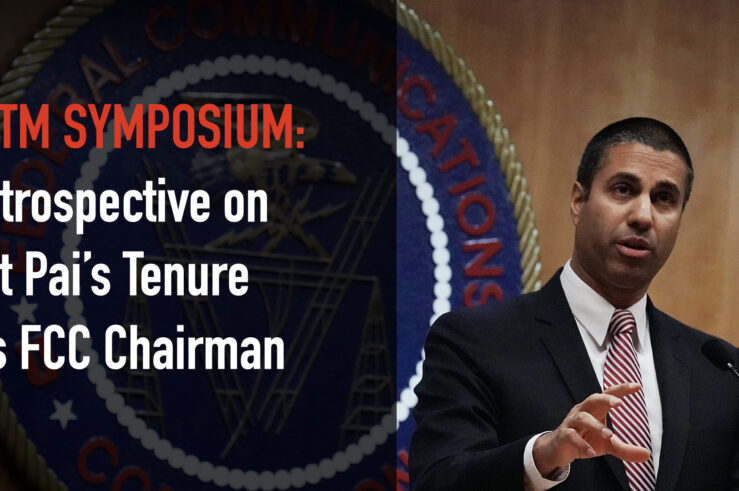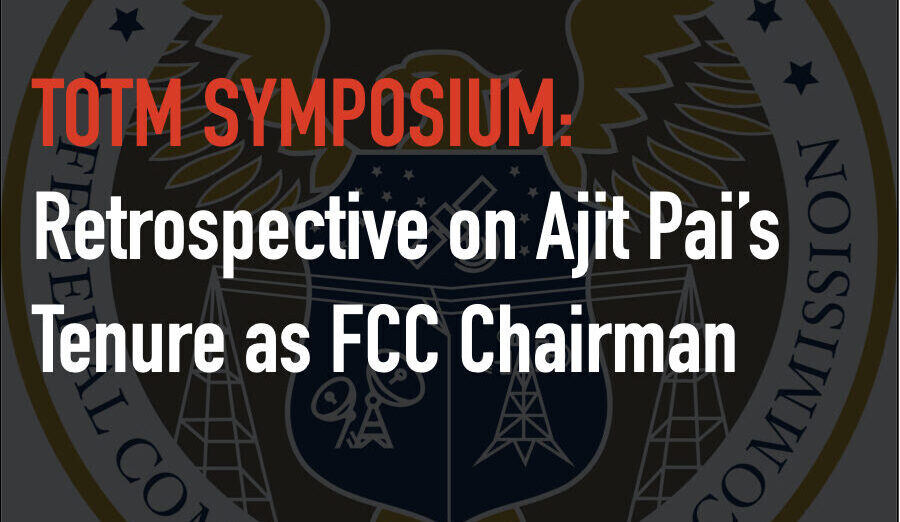
This article is a part of the Retrospective on Ajit Pai's Tenure as FCC Chairman symposium.

For many, the chairmanship of Ajit Pai is notable for its many headline-grabbing substantive achievements, including the Restoring Internet Freedom order, 5G deployment, and rural buildout—many of which have been or will be discussed in this symposium. But that conversation is incomplete without also acknowledging Pai’s careful attention to the basic blocking and tackling of running a telecom agency. The last four years at the Federal Communications Commission were marked by small but significant improvements in how the commission functions, and few are more important than the chairman’s commitment to transparency.
Draft Orders: The Dark Ages Before 2017
This commitment is most notable in Pai’s revisions to the open meeting process. From time immemorial, the FCC chairman would set the agenda for the agency’s monthly meeting by circulating draft orders to the other commissioners three weeks in advance. But the public was deliberately excluded from that distribution list. During this period, the commissioners would read proposals, negotiate revisions behind the scenes, then meet publicly to vote on final agency action. But only after the meeting—often several days later—would the actual text of the order be made public.
The opacity of this process had several adverse consequences. Most obviously, the public lacked details about the substance of the commission’s deliberations. The Government in the Sunshine Act requires the agency’s meetings to be made public so the American people know what their government is doing. But without the text of the orders under consideration, the public had only a superficial understanding of what was happening each month. The process was reminiscent of House Speaker Nancy Pelosi’s famous gaffe that Congress needed to “pass the [Affordable Care Act] bill so that you can find out what’s in it.” During the high-profile deliberations over the Open Internet Order in 2015, then-Commissioner Pai made significant hay over this secrecy, repeatedly posting pictures of himself with the 300-plus-page order on Twitter with captions such as “I wish the public could see what’s inside” and “the public still can’t see it.”
Other consequences were less apparent, but more detrimental. Because the public lacked detail about key initiatives, the telecom media cycle could be manipulated by strategic leaks designed to shape the final vote. As then-Commissioner Pai testified to Congress in 2016:
[T]he public gets to see only what the Chairman’s Office deigns to release, so controversial policy proposals can be (and typically are) hidden in a wave of media adulation. That happened just last month when the agency proposed changes to its set-top-box rules but tried to mislead content producers and the public about whether set-top box manufacturers would be permitted to insert their own advertisements into programming streams.
Sometimes, this secrecy backfired on the chairman, such as when net-neutrality advocates used media pressure to shape the 2014 Open Internet NPRM. Then-Chairman Tom Wheeler’s proposed order sought to follow the roadmap laid out by the D.C. Circuit’s Verizon decision, which relied on Title I to prevent ISPs from blocking content or acting in a “commercially unreasonable manner.” Proponents of a more aggressive Title II approach leaked these details to the media in a negative light, prompting tech journalists and advocates to unleash a wave of criticism alleging the chairman was “killing off net neutrality to…let the big broadband providers double charge.” In full damage control mode, Wheeler attempted to “set the record straight” about “a great deal of misinformation that has recently surfaced regarding” the draft order. But the tempest created by these leaks continued, pressuring Wheeler into adding a Title II option to the NPRM—which, of course, became the basis of the 2015 final rule.
This secrecy also harmed agency bipartisanship, as minority commissioners sometimes felt as much in the dark as the general public. As Wheeler scrambled to address Title II advocates’ concerns, he reportedly shared revised drafts with fellow Democrats but did not circulate the final draft to Republicans until less than 48 hours before the vote—leading Pai to remark cheekily that “when it comes to the Chairman’s latest net neutrality proposal, the Democratic Commissioners are in the fast lane and the Republican Commissioners apparently are being throttled.” Similarly, Pai complained during the 2014 spectrum screen proceeding that “I was not provided a final version of the item until 11:50 p.m. the night before the vote and it was a substantially different document with substantively revised reasoning than the one that was previously circulated.”
Letting the Sunshine In
Eliminating this culture of secrecy was one of Pai’s first decisions as chairman. Less than a month after assuming the reins at the agency, he announced that the FCC would publish all draft items at the same time they are circulated to commissioners, typically three weeks before each monthly meeting. While this move was largely applauded, some were concerned that this transparency would hamper the agency’s operations. One critic suggested that pre-meeting publication would hamper negotiations among commissioners: “Usually, drafts created negotiating room…Now the chairman’s negotiating position looks like a final position, which undercuts negotiating ability.” Another, while supportive of the change, was concerned that the need to put a draft order in final form well before a meeting might add “a month or more to the FCC’s rulemaking adoption process.”
Fortunately, these concerns proved to be unfounded. The Pai era proved to be the most productive in recent memory, averaging just over six items per month, which is double the average number under Pai’s immediate predecessors. Moreover, deliberations were more bipartisan than in years past: Nathan Leamer notes that 61.4% of the items adopted by the Pai FCC were unanimous and 92.1% were bipartisan—compared to 33% and 69.9%, respectively, under Chairman Wheeler.
This increased transparency also improved the overall quality of the agency’s work product. In a 2018 speech before the Free State Foundation, Commissioner Mike O’Rielly explained that “drafts are now more complete and more polished prior to the public reveal, so edits prior to the meeting are coming from Commissioners, as opposed to there being last minute changes—or rewrites—from staff or the Office of General Counsel.” Publishing draft orders in advance allows the public to flag potential issues for revision before the meeting, which improves the quality of the final draft and reduces the risk of successful post-meeting challenges via motions for reconsideration or petitions for judicial review. O’Rielly went on to note that the agency seemed to be running more efficiently as well, as “[m]eetings are targeted to specific issues, unnecessary discussions of non-existent issues have been eliminated, [and] conversations are more productive.”
Other Reforms
While pre-meeting publication was the most visible improvement to agency transparency, there are other initiatives also worth mentioning.
- Limiting Editorial Privileges: Chairman Pai dramatically limited “editorial privileges,” a longtime tradition that allowed agency staff to make changes to an order’s text even after the final vote. Under Pai, editorial privileges were limited to technical and conforming edits only; substantive changes were not permitted unless they were proposed directly by a commissioner and only in response to new arguments offered by a dissenting commissioner. This reduces the likelihood of a significant change being introduced outside the public eye.
- Fact Sheet: Adopting a suggestion of Commissioner Mignon Clyburn, Pai made it a practice to preface each published draft order with a one-page fact sheet that summarized the item in lay terms, as much as possible. This made the agency’s monthly work more accessible and transparent to members of the public who lacked the time to wade through the full text of each draft order.
- Online Transparency Dashboard: Pai also launched an online dashboard on the agency’s website. This dashboard offers metrics on the number of items currently pending at the commission by category, as well as quarterly trends over time.
- Restricting Comment on Upcoming Items: As a gesture of respect to fellow commissioners, Pai committed that the chairman’s office would not brief the press or members of the public, or publish a blog, about an upcoming matter before it was shared with other commissioners. This was another step toward reducing the strategic use of leaks or selective access to guide the tech media news cycle.
And while it’s technically not a transparency reform, Pai also deserves credit for his willingness to engage the public as the face of the agency. He was the first FCC commissioner to join Twitter, and throughout his chairmanship he maintained an active social media presence that helped personalize the agency and make it more accessible. His commitment to this channel is all the more impressive when one considers the way some opponents used these platforms to hurl a steady stream of hateful, often violent and racist invective at him during his tenure.
Pai deserves tremendous credit for spearheading these efforts to bring the agency out of the shadows and into the sunlight. Of course, he was not working alone. Pai shares credit with other commissioners and staff who supported transparency and worked to bring these policies to fruition, most notably former Commissioner O’Rielly, who beat a steady drum for process reform throughout his tenure.
We do not yet know who President Joe Biden will appoint as Pai’s successor. It is fair to assume that whomever is chosen will seek to put his or her own stamp on the agency. But let’s hope that enhanced transparency and the other process reforms enacted over the past four years remain a staple of agency practice moving forward. They may not be flashy, but they may prove to be the most significant and long-lasting impact of the Pai chairmanship.




